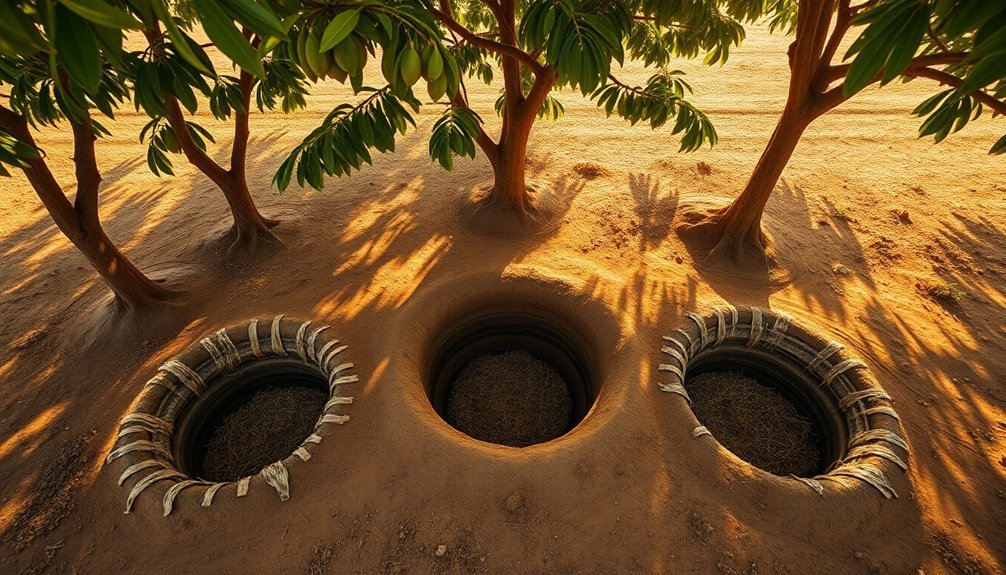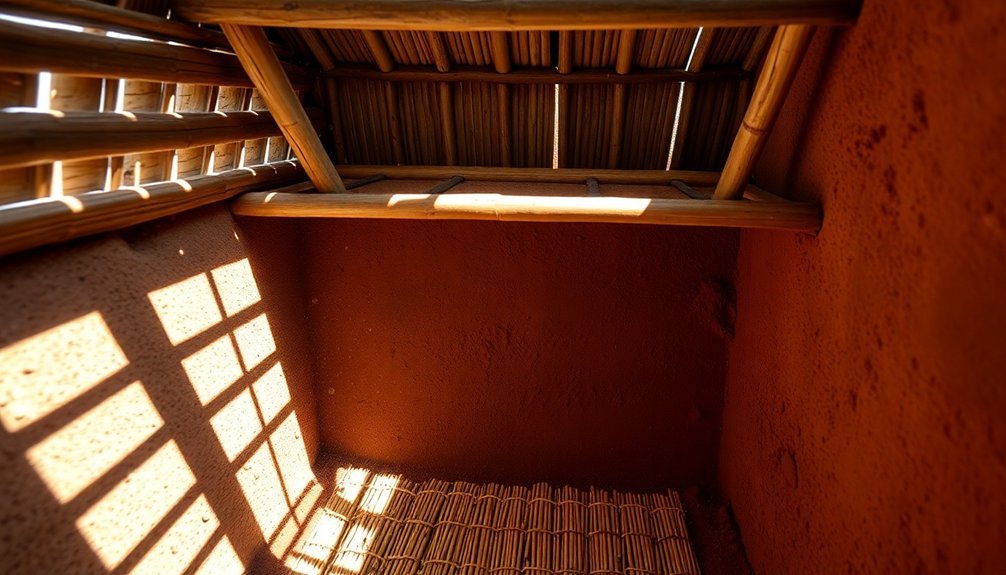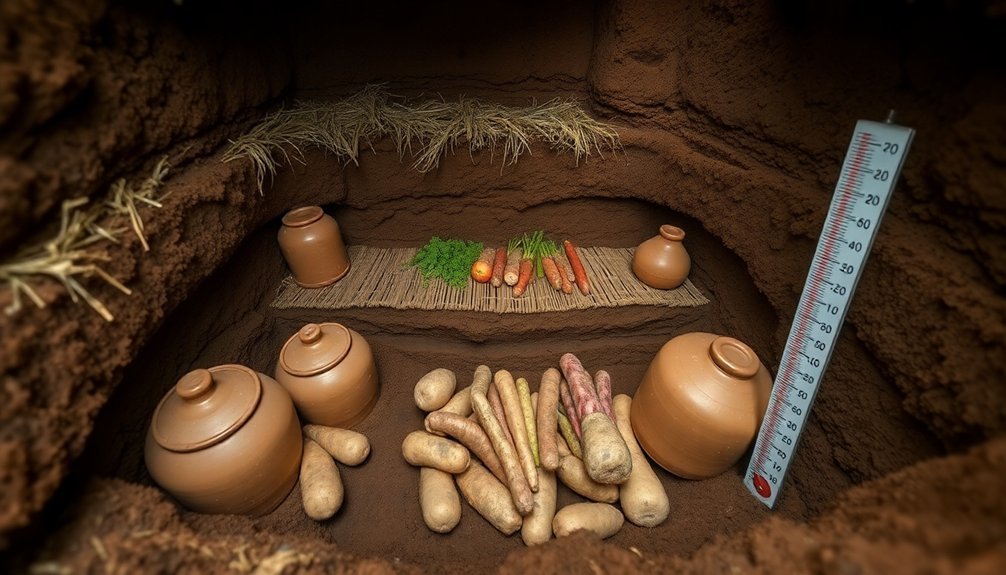Your best defense against food spoilage in earth pits starts with strategic site selection on high ground with clay soil. You'll want to design a temperature-controlled chamber using concrete's thermal properties to maintain 50-55°F year-round. Don't skip proper moisture management – install dehumidification systems and multilayer barriers to keep things dry. Traditional sealing techniques using charcoal, salt, and sand mixtures create an effective preservation barrier. You'll also need proper ventilation with wall-mounted fans moving 36-44 cubic feet of air per minute. These proven methods will lead you to a deeper understanding of food preservation techniques.
Strategic Site Location Selection

When it comes down to selecting an earth pit location, choosing the right spot can make or break your food storage success. You'll want to focus on finding the highest point in your local landscape, as this prevents both surface and underground water movement that could compromise your stored food.
Look for sites with clay or conglomerate soil, as these soil types allow you to dig nearly vertical pit sides that won't collapse. You'll need to guarantee the location has excellent drainage so rainfall flows away from rather than into the pit. Taking time to identify unclear elements in your site selection process will help avoid costly mistakes later.
Don't place your pit in low-lying areas where water tends to accumulate. Position your pit close to your grain production or feeding areas to minimize transportation time and costs. You'll want year-round vehicle access, but don't place multiple pits too close together as this can create water seepage problems.
In cooler climates, locate your pit on the north side of a sheltering object. If you're in a warmer region, the south side might work better due to colder winter temperatures.
Always verify that your chosen location isn't in a potential flood zone and allows for straightforward construction and maintenance.
Temperature-Controlled Underground Chamber Design
Setting up a temperature-controlled underground chamber calls for strategic design elements that work together to maintain ideal storage conditions.
You'll need to incorporate thermal mass materials like concrete, which has a specific heat capacity of 0.9 KJ/kg K, to regulate temperature effectively. Using rippled concrete surfaces will maximize heat exchange through increased surface contact. Similar to the Renaissance villas in Costozza, historical structures have proven the effectiveness of underground chambers for food preservation.
Your chamber's ventilation system should draw fresh air through underground thermal pipes, where it'll naturally cool or warm based on earth temperatures.
You can install insulated displacement plenums and adjustable floor grilles to distribute this temperature-controlled air efficiently throughout your storage space. For peak performance, include air diversion systems that'll adjust airflow based on outdoor temperature changes.
You should position your chamber at a depth where ground temperatures remain consistently between 50-55 degrees year-round.
Install vertical pipes and directional outlets to distribute cooled air directly to your food storage areas. During extreme heat, you can integrate evaporative cooling for additional temperature control.
This system will deliver more than double the fresh air of conventional HVAC systems while cutting energy costs by up to 60%.
Moisture Management Systems

Moisture control expertise makes or breaks your earth pit's food preservation capabilities. You'll need multiple layers of defense against humidity to keep your stored food from spoiling. Install dehumidification systems that cool the air below its dew point, forcing moisture to condense and drain away from your storage area. Incorporating multilayer film barriers helps create superior moisture protection without using metal components.
For peak protection, incorporate modular humidity control systems with sensors and regenerative desiccants to maintain ideal moisture levels.
Your pit's moisture management should include these critical elements:
- Layered moisture absorption structures featuring hydrogel sheets and ventilation flutes to trap condensation before it reaches your food.
- Interchangeable nesting compartments with flange seals to prevent moisture migration between different food types.
- Positive pressure ventilation systems that continuously circulate dry air throughout your storage space.
When you're organizing your pit's storage, use compartmentalized containers with proper seals to keep foods with different moisture requirements separate.
Place moisture-absorbing materials strategically throughout your storage areas, and make sure all surfaces stay above the dew point temperature to prevent condensation.
Remember to maintain your dehumidification equipment regularly and replace or regenerate desiccants when they become saturated.
Traditional Sealing Techniques
Proper sealing of your earth pit requires time-tested traditional methods that combine specific ratios of natural materials.
You'll need to mix equal parts of wood coal powder, salt, and sand to create an effective sealing mixture that prevents food spoilage. The wood coal powder acts as a conductor while protecting metal components from corrosion, and the salt enhances conductivity when dissolved in water.
Start by excavating a pit measuring 1.5m x 1.5m with a depth of 3m. Place a GI plate (500mm x 500mm x 10mm) in the center, connecting it to the surface using GI pipes or strips.
You'll need to layer your charcoal and salt mixture strategically throughout the pit, allowing sand to create pathways for water percolation.
Don't forget to install a T-section cover on top of your GI pipe to keep out debris. You'll need to water your pit regularly, especially during dry periods, to maintain ideal moisture levels.
The coal's carbon content guarantees good conductivity, while the sand's porosity helps distribute moisture evenly. This traditional sealing method keeps your pit's resistance low and maintains consistent conditions for food preservation.
Proper Pit Ventilation Methods

Implementing effective ventilation in your earth pit requires a strategic balance between airflow and gas control.
You'll want to focus on wall-mounted fans rather than pit fans, as they're considerably more effective at reducing unwanted emissions while preventing food spoilage. Wall fans can reduce pollutants by 10-20% compared to pit-mounted alternatives, which tend to accelerate food decomposition through unnecessary warming.
To maintain ideal ventilation in your earth pit, follow these key principles:
- Maintain airflow at 36-44 cubic feet per minute to guarantee proper downward air movement while preventing excessive gas accumulation.
- Install wall fans strategically to pull air across the pit surface minimally, avoiding unnecessary warming that accelerates food decomposition.
- Keep floor openings between 11-14% of total surface area, using 6-8 inch slats with 1-inch slots for proper ventilation.
Don't let stagnant air build up in your pit, but avoid excessive airflow that could speed up decomposition.
If you're looking to enhance your ventilation system, consider adding biofilters or scrubbers – they can reduce emissions by over 50% while helping preserve your stored food longer.
Frequently Asked Questions
How Do You Safely Retrieve Grain During Heavy Rainfall or Flooding?
You'll need to remove grain from the top or sides before flooding reaches bins. Don't use underfloor conveyors once water enters. Always wear protective gear and guarantee electrical components are safe first.
What Emergency Measures Can Prevent Pit Collapse During Unexpected Soil Shifts?
You'll need to install temporary barriers like silt fences immediately, divert water flow with heavy-duty ropes, reinforce slopes using onsite materials, and monitor ground movement constantly. Don't forget to alert nearby workers.
How Often Should Underground Storage Pits Be Professionally Inspected?
You'll need weekly visual checks, monthly leak monitoring, and annual professional inspections of your underground storage pit. Don't skip the required 3-year testing of containment systems to guarantee structural integrity and safety.
Can Multiple Types of Grains Be Stored in Separate Sections?
You can store different grains in separate sections of your storage area using dividers or individual containers. Be sure you're labeling each section clearly and keeping similar grains with matching storage requirements together.
What Methods Detect Harmful Gas Buildup in Long-Term Underground Storage?
You'll need interstitial monitors between tank walls, vapor monitoring wells near storage areas, groundwater wells below water tables, and automated gauging systems to detect harmful gas accumulation in underground storage facilities.
In Summary
You've now learned the essential techniques for creating an effective earth pit storage system. By carefully selecting your site, designing temperature-controlled chambers, managing moisture levels, implementing proper sealing, and ensuring adequate ventilation, you'll greatly extend your food's shelf life. Put these methods into practice, and you'll enjoy fresh, well-preserved produce throughout the year while reducing waste and saving money.





Leave a Reply